If you love tender, fall-apart braised beef stew, you definitely need to check out this Bo Kho recipe! It’s a delicious authentic Vietnamese beef stew that’s made by braising beef with spices and aromatics from lemongrass to star anise. It’s incredibly comforting and perfect for special occasions or an everyday meal.
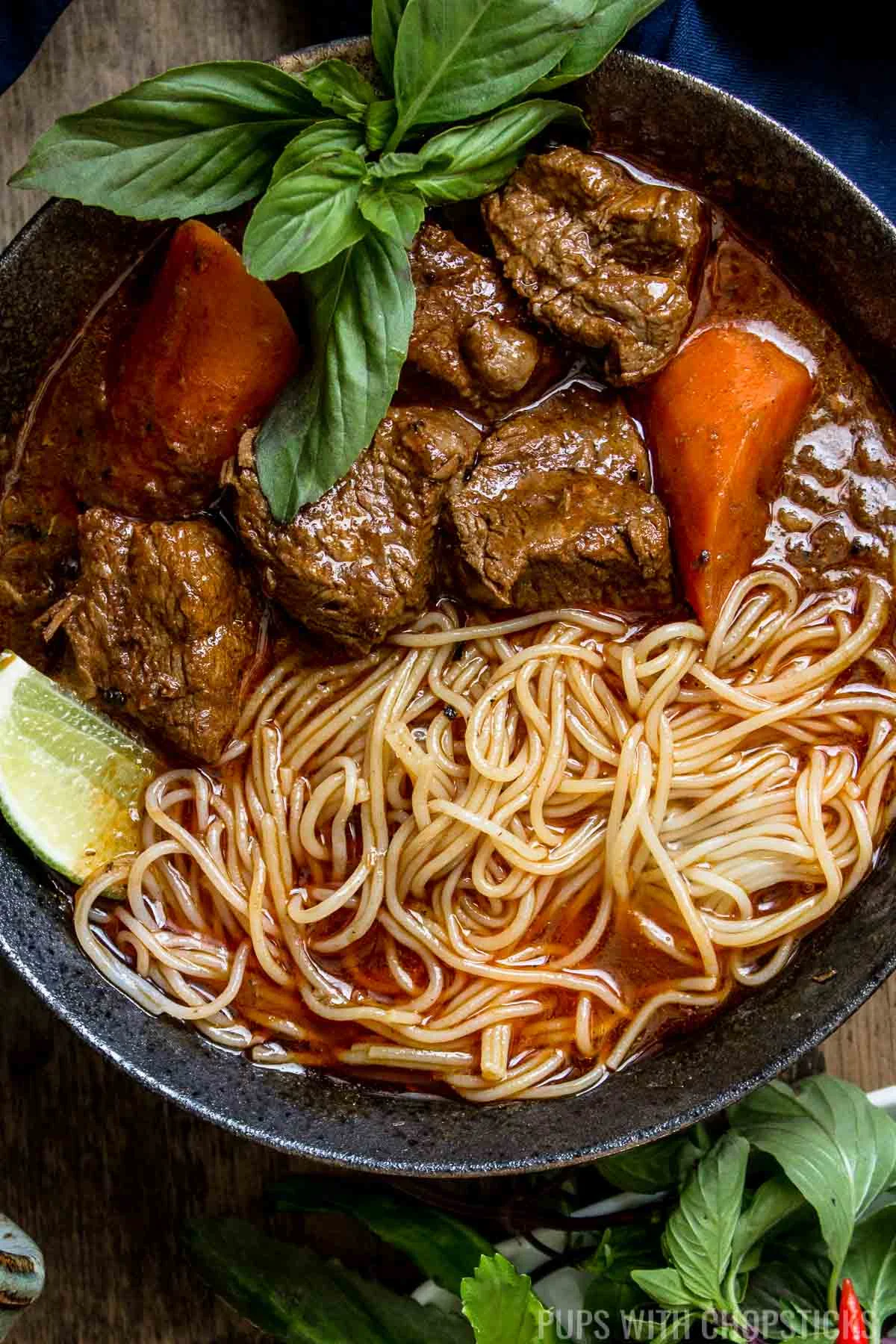
Table of Contents
- What is Bo Kho?
- Why You’ll Love This Bo Kho Recipe
- Ingredients to Make Bo Kho
- Best Meat for Bo Kho
- How to Make Authentic Bo Kho (Step by Step)
- Joyce’s Tips For Making the Best Bo Kho
- Serving Suggestions for Vietnamese Beef Stew
- Recipe Variation Ideas for Bo Kho
- Frequently Asked Questions
- How to Store Leftover Bo Kho
- More Vietnamese Recipes You May Like
- Recipe Card
- More Cozy Recipes You May Enjoy
Vietnamese Bo kho is hearty and tastes incredible served as a beef noodle soup with rice noodles or dipped in a Vietnamese baguette. It’s the sort of meal that’s satisfying, cozy and comforting, and tastes absolutely delicious, and there just isn’t anything like having a homemade version!
That being said, Vietnamese cuisine doesn't really have a shortage of wonderful cozy dishes, from spicy bun bo hue (spicy Vietnamese beef noodle soup) to the sweet and tangy canh chua soup which is Vietnamese's version of sweet and sour soup, if you're looking for something cozy, you're in the right place.
Read on to learn exactly how to make this delicious traditional bo kho recipe today!
What is Bo Kho?
Bo kho is a very flavorful Vietnamese stew made by braising beef with a lot of fragrant aromatics such as lemongrass, star anise, and cinnamon. This beef stew originates from Southern Vietnam and the word 'kho' is Vietnamese for braise, since you essentially braise the beef in the aromatics.
One of the biggest reasons why I love Bo Kho is because it is such a versatile dish. It can start out like a stew and be eaten with a Vietnamese baguette or some rice.
Similar to another Vietnamese noodle dish called bun bo hue, it can also be served as a soup with rice noodles by thinning out the stew by adding more beef broth or coconut water to it and adding a few additional splashes of fish sauce.
This Vietnamese stew is actually not very different than your traditional beef stew. The main difference is the wonderful Vietnamese aromatics which add a lot of extra flavors. Instead of using traditional herbs like herb de Provence, thyme, or rosemary, Bo Kho uses star anise, lemongrass, and cinnamon.
Why You’ll Love This Bo Kho Recipe
- Traditional and Authentic: This traditional bo kho recipe has been tested and loved by many families. It's a comforting and hearty meal that will surely be a hit with everyone at your dinner table.
- Versatile (Served 2 Ways): Whether you prefer it as a noodle soup or paired with a Vietnamese baguette, this bo kho recipe is incredibly versatile. You can even adjust the spiciness to your liking by adding Thai chilies.
- Tender Flavorful Beef: Using chuck (aka blade roast), ensures that you will never get dry beef and you will always get tender beef every time.
- More Flavorful Than Traditional Beef Stew: Since this Vietnamese beef stew recipe has an abundance of herbs and spices like lemongrass, star anise, and cinnamon sticks on top of the traditional beef stew ingredients like tomato paste, garlic and onions, there's an extra layer of flavor.
Ingredients to Make Bo Kho
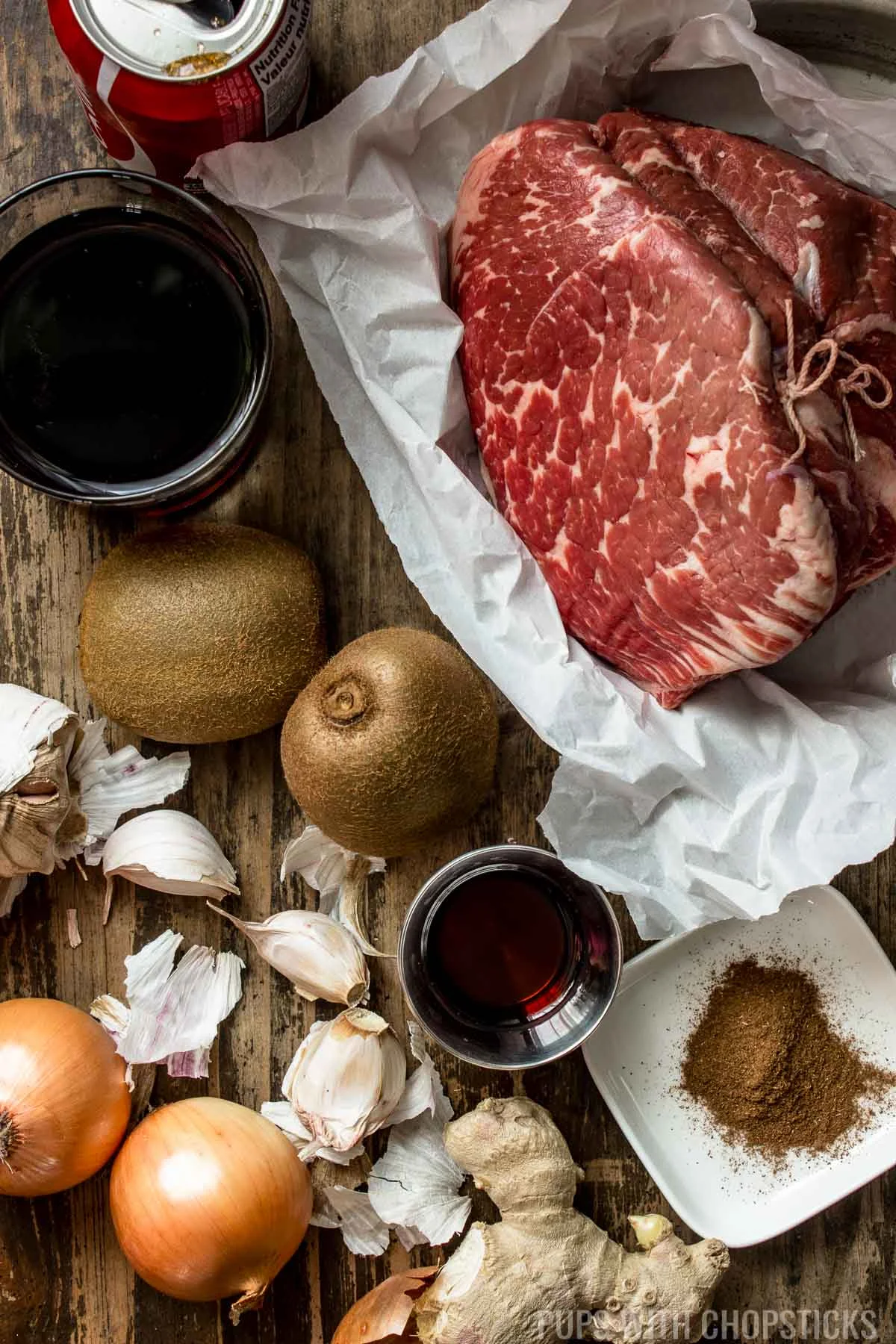
The list of ingredients for bo kho is long but don't let it intimidate you as most of the ingredients are part of the marinade. Once you marinate the beef, braising the beef is easy to do, it just requires time.
For the Marinade:
- Beef: The star of this dish, beef gives this stew its hearty, robust flavor. The type of cut you use can affect the cooking time and texture of the meat, so choose according to your preference. For this stew, I like using beef chuck because the meat doesn't get stringy and dry and gets really tender on its own without any tenderizer. Chuck is also known as blade roast. Oxtail is another favorite option as well but it takes a bit longer to cook. See below for ideas of the different types of beef you can use for this stew.
- Kiwi: I use kiwi as a natural meat tenderizer for this stew. If I use chuck or oxtail, I generally will skip putting in the kiwi because those cuts of meat get tender naturally, the longer you cook it. ⚠It's important not to marinate it for more than 24 hours because kiwi is a very strong meat tenderizer, and it may tenderize the meat too much and make it mushy.
- Cola: I use cola as another tenderizer as well. Cola gives the marinade a bit of sweetness as well which lightly sweetens the stew in the end. Don't worry, you don't pour any of the cola marinade into the stew itself, we discard the marinade. It is also the main liquid of the marinade, so if you decide to omit it, add a bit of water in its place.
- Ginger, Garlic, and Onion: These aromatic ingredients are key for building up the flavor profile of the stew. They're roughly chopped and added to the marinade, infusing the beef with their distinctive tastes.
- Chinese Five Spice Powder: This spice gives the meat marinade a nice spiced flavor
- Fish Sauce: Fish sauce is the salt element of the marinade. You can substitute it with soy sauce, but I highly recommend sticking with fish sauce.
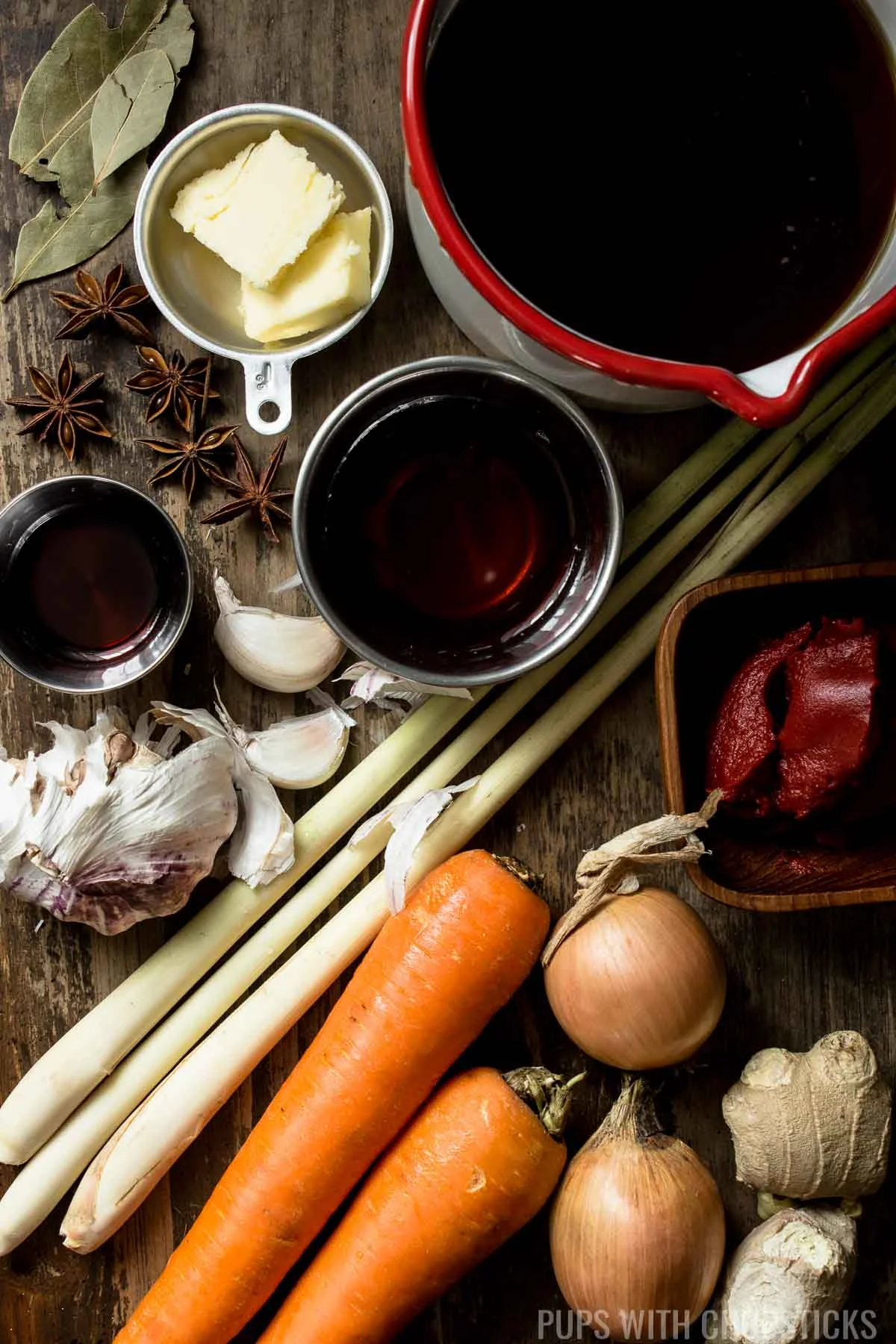
For the Stew:
- Lemongrass: I like to use fresh lemongrass stalks for this recipe, so I can easily find and remove them before serving it. If you are using fresh lemongrass, make sure you remove the outer layer and wash off any sand before smashing it to bruise it to release the flavor. You can find fresh lemongrass at your local Asian grocery store in the fridge. If you can't find fresh lemongrass, you can use frozen pre-ground lemongrass as well, but you won't be able to fish out the lemongrass at the end.
- Broth: I like to use beef broth for this recipe. Try to use low sodium broth, so you can control how salty it is with fish sauce and salt in the end.
- Tomato Paste: Tomato paste is the base flavor of this stew. You can put more to keep the stew thicker to eat with rice or dip with Vietnamese baguettes, or you can put a little less with a bit more broth to thin out the stew to eat with noodles.
- Ginger/Garlic/ Onions: These three aromatics are a must in the stew. Do not omit it, it provides a lot of flavor to it.
- Butter: I like to use a bit of butter to help the browning of the beef.
- Shaoxing Cooking Wine: This cooking wine adds another layer of flavor to the stew. If you cannot find it, you can substitute it with dry sherry.
- Cinnamon/Star Anise/Bay Leaves: These three spices are a must. They give the stew another layer of flavor that differentiates the standard stew from a Vietnamese beef stew.
- Fish Sauce: This will give your stew a lot of flavors, as well as give its saltiness. I highly recommend you don't substitute this out.
(Optional) For Transforming into a Noodle Soup:
- Beef Broth: You can add more beef broth to the stew to give it a thinner consistency that’s more like a soup.
- Fish Sauce: Adjust to your liking to find the perfect balance of savory and salty.
For Garnishing:
- White Onion: Onions are essential for adding a touch of sweetness and a lot of flavor to the dish. Make sure to slice them thinly and don't skip this ingredient - it's a game-changer!
- Fresh Basil: Fresh basil brings a refreshing, aromatic note to the dish, cutting through the rich flavors of the stew.
- Lime Wedges: Lime wedges provide a much-needed citrusy tang, balancing out the rich flavors of the stew.
- Crispy Deep Fried Shallots: These add a delightful crunch and a touch of sweetness to the dish, perfectly complementing the tender, braised beef.
Best Meat for Bo Kho
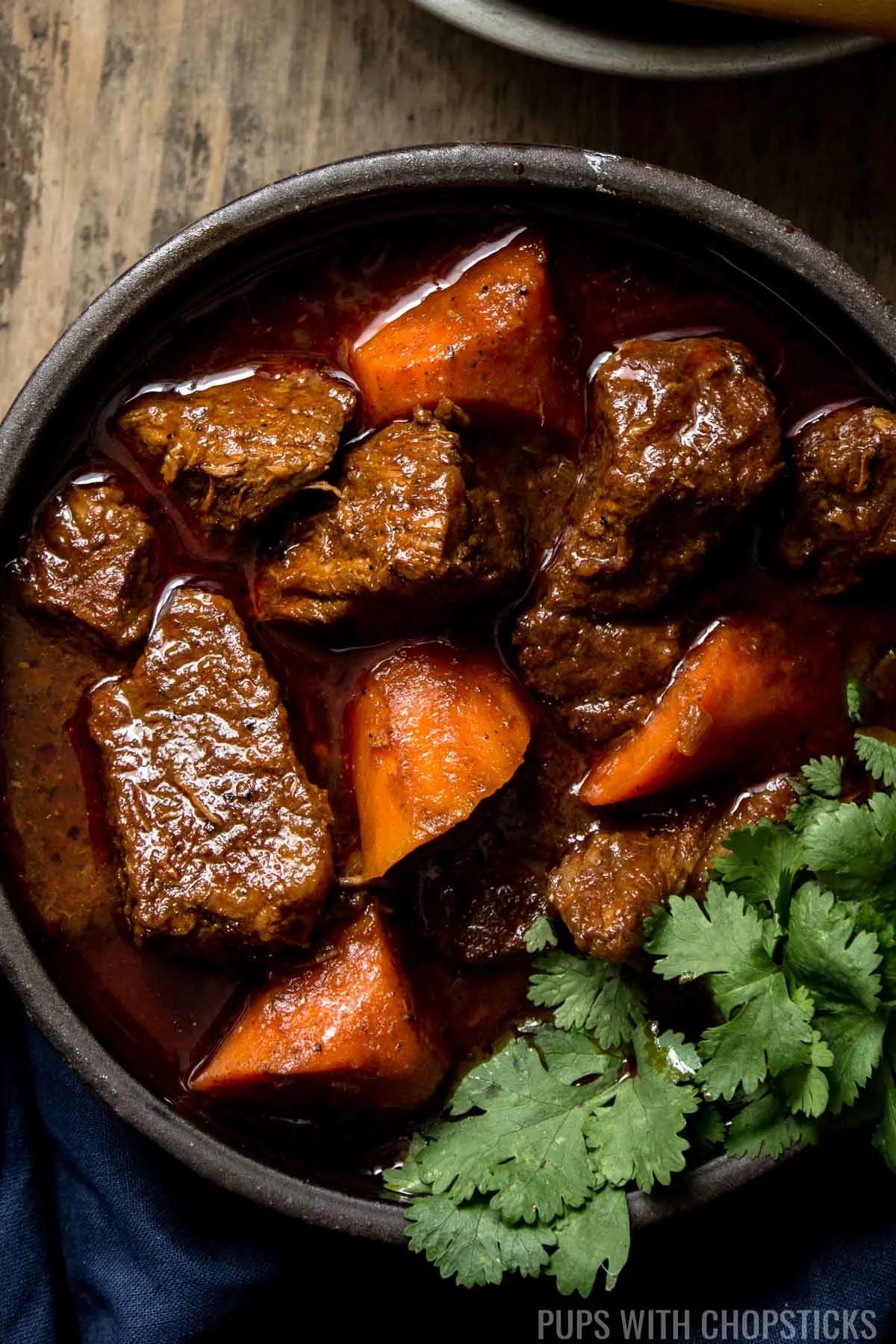
The type of beef cut you use in this Bo Kho is important if you want something tender without it being too dry or too stringy.
Here are a few I turn to whenever I make this delicious Vietnamese beef stew, feel free to switch this up and experiment with it! Also keep in mind, that cooking time will also vary depending on what cut of beef you use.
- Beef Shank or Oxtail: I personally found the best cut of beef for this stew was beef shank or oxtail, partially because of all the connective tissues which eventually will melt into the stew giving it a richer and silkier broth. They are also very tender cuts of beef that have a nice chew to them without stringiness. The downside to beef shank and oxtail is that it takes a lot longer to cook.
- Chuck (aka top or bottom blade roast): This is my second favorite meat to use for the recipe. This is a fattier cut of meat which also has a great texture. Chuck is often labeled as a blade roast or a blade pot roast as well.
- Boneless Beef Ribs: This one is more on the expensive side, but the marbling of fats combined with the connective tissues makes this a great cut of beef to use in Bo Kho. The final product when cooked is a very tender and buttery chunk of beef that practically melts in your mouth.
- Beef brisket: I tend to stay away from it since the texture can be a bit stringy and since it is a tougher cut of meat, it takes a very long time to cook.
- Beef Tendon: This is a nice addition to the stew and can thicken it very nicely with its gelatinous texture but it is a very tough piece of meat and I recommend pressure cooking this ahead of time and adding it in the last hour of simmering the stew.
How to Make Authentic Bo Kho (Step by Step)
Marinating the Beef
Prepare the Beef: Start by cutting the beef into chunks of about one and a half inches and place them in a large bowl.
Prepare the Marinade: Chop the garlic and onions roughly, slice the ginger into thick matchsticks, and add them to the bowl. Next, add the five-spice, fish sauce, and cola to the mix.
Use Kiwi as a Tenderizer: Peel the kiwi and smash it with a fork before adding it to the bowl. Stir everything well to ensure the beef is well coated with the marinade. Let it marinate overnight in the fridge. If pressed for time, marinate it for at least four hours at room temperature. Don't exceed a marinating time of more than twenty-four hours as the kiwi may over-tenderize the beef, making it mushy.
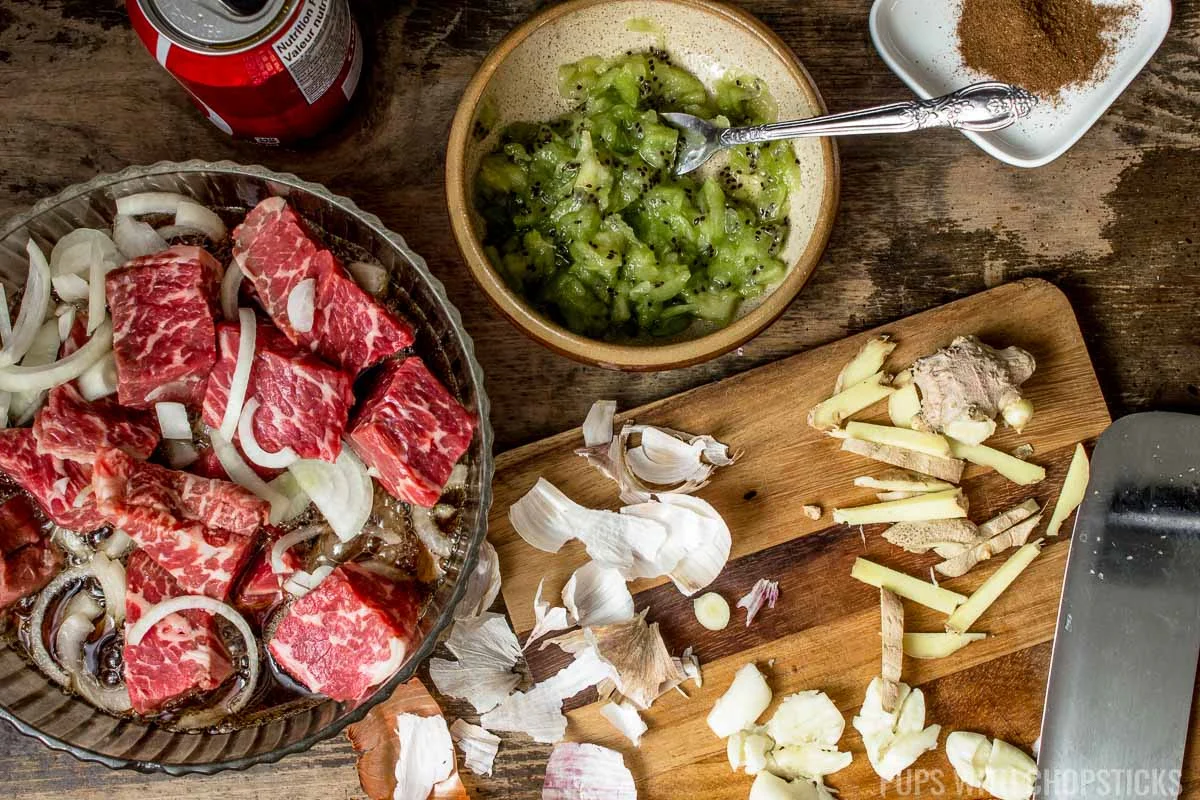
Preparing the Other Ingredients
Drain the Marinade: Remove the marinated beef from the fridge and drain the liquid. Discard the onions, garlic, and ginger.
Prepare the Aromatics: Let the beef sit at room temperature for an hour. Meanwhile, peel and slice an onion, chop the garlic roughly, and slice the ginger. Chop the carrot into two-inch chunks.
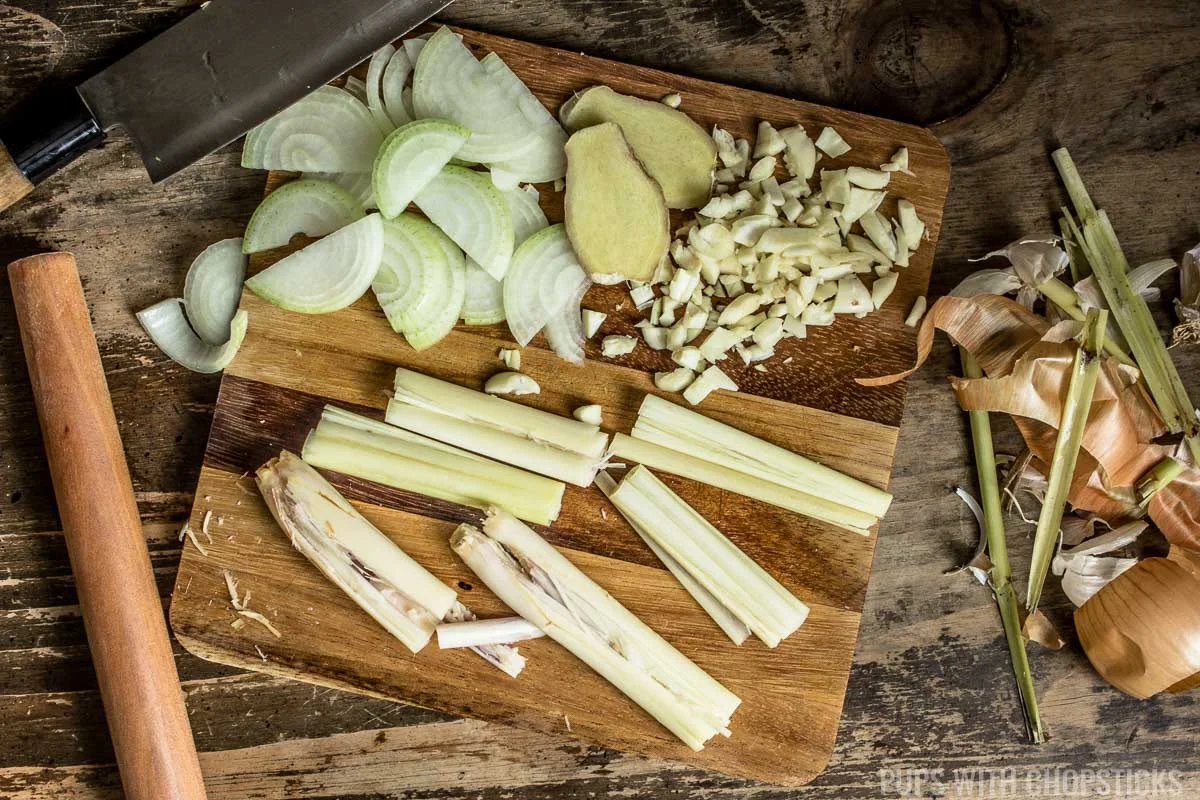
Prepare the Lemongrass: Peel the dried outer layer of the lemongrass and cut off the dried tips. Wash it thoroughly to remove any sand. Cut it into two to three-inch chunks and smash it with a rolling pin or the blunt back of a knife to release the oils.
Putting It All Together
Heat the Pot: Heat a large heavy-bottomed pot or a dutch oven over medium heat. Add a bit of oil and one to two tablespoons of butter.
Brown the Beef: Add the beef one piece at a time, taking care not to crowd the pot. Brown the beef in batches. Keep in mind that the beef browns better if you touch it less, it gives it a chance to form a crust.
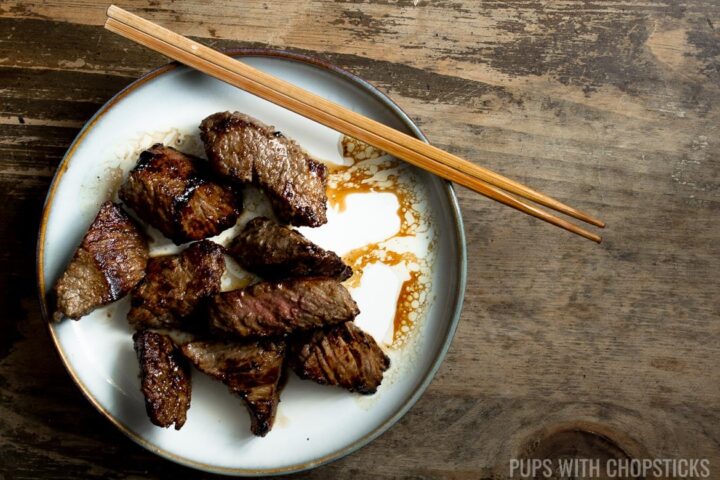
Add the Ingredients: Once all the beef has browned, add it back to the pot along with the chopped onions, garlic, ginger, lemongrass, cinnamon stick, and star anise. Toast these with the meat for about five minutes.
Add the Liquids: Add in the tomato paste and stir well. Cook for another two to three minutes before adding the cooking wine, beef broth, and bay leaves. Gently scrape the bottom of the pan if there are brown bits stuck to the bottom (this is where a ton of flavor is).
Let it Simmer: Bring the stew to a boil, then reduce the heat to low. Cover the pot and let it simmer for two and a half hours. If you are using oxtail or beef shank, you will need to cook it a lot longer, by approximately 1 hour more.
Check for Tenderness: After two and a half hours, stir the stew and check the beef for tenderness. If it’s still tough, continue cooking for another half an hour. If the stew needs more liquid, add more beef broth or water.
Add the Final Touches: Once the beef is tender, add the carrots and continue cooking for another half an hour until the carrots are soft. Add fish sauce to taste, then remove the lemongrass, star anise, and bay leaves before serving.
Optional: Turning It Into A Beef Noodle Soup
Add More Broth: Once the stew is done, add one to three cups of beef broth, depending on the desired thickness for the soup.
Season and Serve: Add fish sauce to taste and serve with noodles and thinly sliced sweet onions. Garnish with lime wedges.
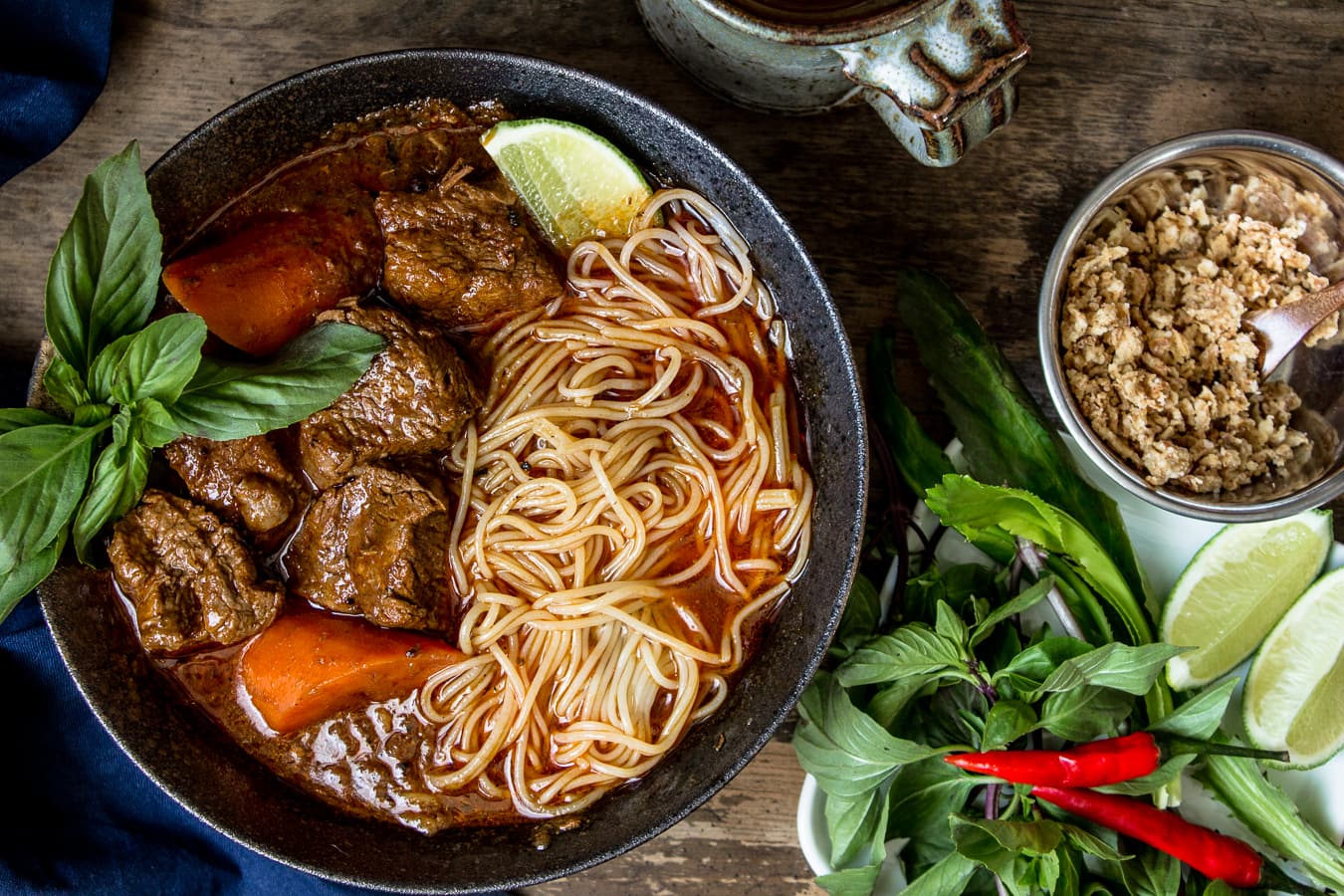
Joyce’s Tips For Making the Best Bo Kho
- Choose the Right Cut of Beef: Different cuts of beef will give different textures and flavors to your Bo Kho. If you prefer a richer, gelatinous texture, go for the beef shank or oxtail. However, remember that these cuts will need a longer cooking time.
- Avoid 'Stewing Beef' At The Store: A lot of grocery stores sell generic packs of 'stewing beef', avoid those because they will often result in stringy dry beef. Always opt for chuck, which is also called blade roasts.
- Marinate the Beef Properly: Marinating the beef overnight will allow the flavors to penetrate deeply into the meat. However, be sure not to marinate the meat for more than a day as the kiwi used in the marinade is a strong tenderizer and may make the meat too soft.
- Don't Rush the Browning Process: When browning the beef, make sure not to crowd the pot and give the meat ample time to form a crust. This Millard reaction step is crucial in developing a rich and deep flavor in your Bo Kho.
- Add More Broth to Serve With Noodles: If you prefer a thinner soup-like consistency for your Bo Kho so you can serve it with noodles, feel free to add more beef broth or water during the cooking process. Remember, cooking is all about adjusting to your personal taste so you'll also need to adjust the amount of fish sauce as well!
- Remove Aromatics Before Serving: Before serving your Bo Kho, remember to fish out the lemongrass, star anise, and bay leaves. These aromatics have done their job in flavoring the stew and can be removed for a better eating experience.
Serving Suggestions for Vietnamese Beef Stew
This delicious Vietnamese beef stew is a hearty meal on its own, but here are a few serving suggestions you can try:
- For a traditional meal, enjoy your Bo Kho with a warm Vietnamese baguette or even a French baguette. The crusty bread is perfect for dipping into the flavorful broth, making for a satisfying and delicious option
- If you're in the mood for a hearty lunch, serve your Bo Kho with rice noodles. The noodles soak up the rich, aromatic broth, creating a comforting, filling meal.
- For a truly indulgent treat, serve your Bo Kho with a side of Nem Nuong. The grilled Vietnamese pork sausages add an extra layer of flavor and texture to the meal.
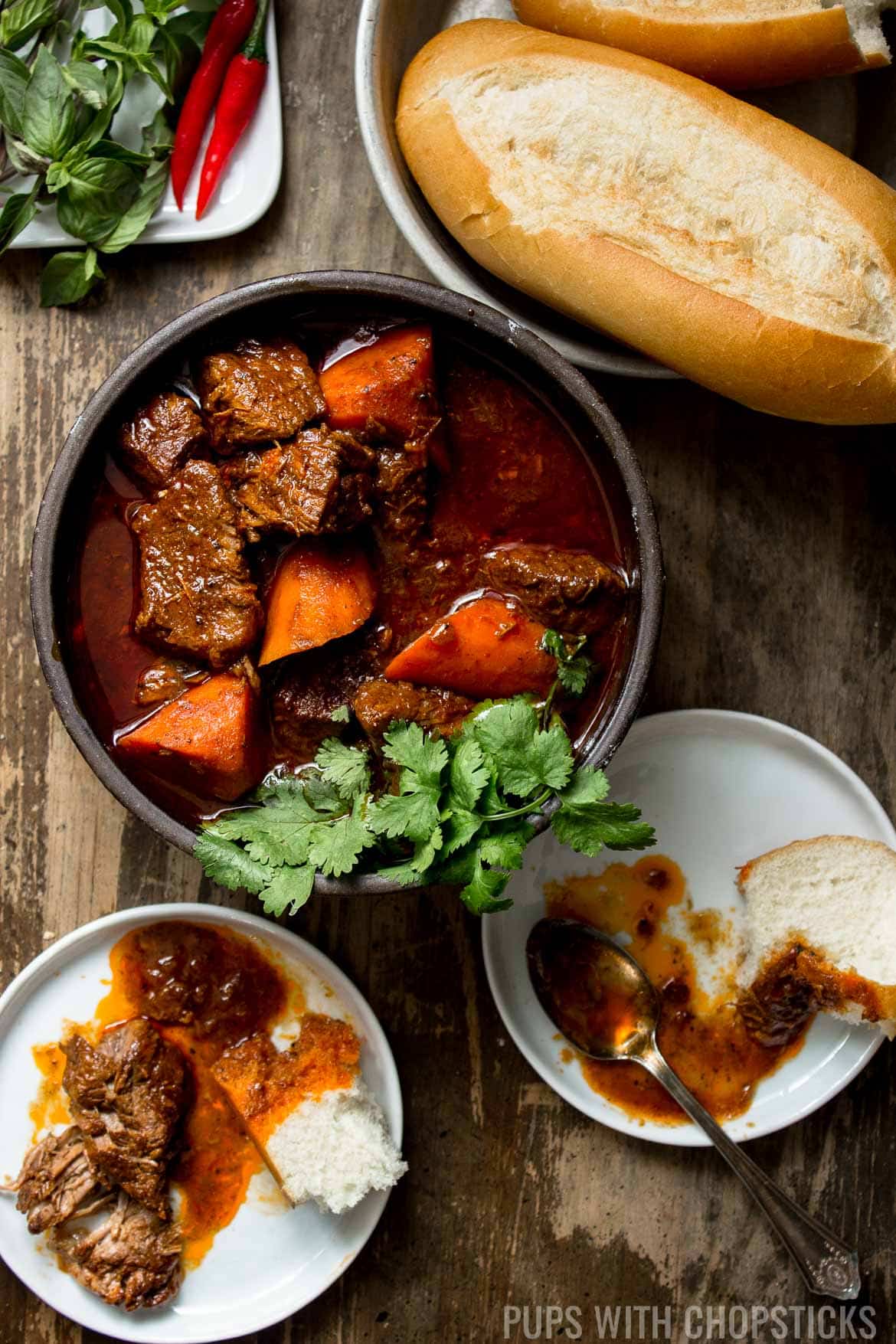
Recipe Variation Ideas for Bo Kho
This delicious bo kho recipe is so flavorful and easy to make, you'll want to try out some of these delicious variations! Here are some great ideas:
- Go Vegetarian: Want to make this dish vegetarian-friendly? Substitute the beef with firm tofu or a mix of hearty vegetables like mushrooms, eggplant, and bell peppers. You'll be surprised at how well these ingredients soak up the rich flavors of the stew.
- Add Some Heat: If you're a fan of spicy food, this variation is a must-try. Add a couple of Thai chilies or a teaspoon of red pepper flakes to the stew while it's simmering. This will give your Bo Kho a nice kick and deepen its flavors.
- Try It With Seafood: For a unique twist on traditional Bo Kho, try using seafood instead of beef. Shrimp, scallops, or even chunks of fish would work well. Just remember to adjust the cooking time as seafood cooks faster than beef.
- Add More Veggies: If you're looking to make this dish even healthier, consider adding more vegetables. Besides carrots, you can add potatoes, peas, or even spinach for an extra nutrition boost.
Frequently Asked Questions
I personally like to use beef shank or oxtail for bo kho because of all the connective tissues in the meat which break down to make a rich and silkier stew They are also incredibly tender cuts of beef if they are cooked long enough.
Alternatively, you can also use beef chuck (aka top or bottom blade roast), and boneless beef ribs, which are easier to find and also very tender and flavorful.
If you have the time (or a pressure cooker) you can also add beef tendon as well, which I also highly recommend. I've gone into more detail about the types of beef in the post above.
I like to marinate the beef in kiwi and cola overnight to tenderize the beef. You can also use one or the other if you don't have both. It also provides a bit of sweetness to the marinade as well.
When I can't get a hold of Vietnamese baguettes here, I will use French baguettes which are easier to find. French banquettes are longer in size and slightly denser but it's just as tasty and a very good substitute!
I like to cut them into 5-6 inch sized pieces and toast them in the oven for a few minutes to get them crusty before serving with bo kho.
How to Store Leftover Bo Kho
Once the bo kho has cooled down, transfer it into an airtight container. It can be safely stored in the fridge for up to three days.
When you're ready to enjoy your bo kho again, you can reheat it on the stove. Pour the stew into a pot and heat it over medium heat until it's warmed through. Remember to stir occasionally to avoid it from sticking to the pot.
If you're not planning to consume the leftovers within a few days, freezing is a great option. Bo kho freezes well due to the high-fat content from the beef but the texture of the carrots may change. Just make sure to pack it in a freezer-safe container or heavy-duty freezer bag. It can be kept in the freezer for up to three months.
When you're ready to eat your frozen Bo Kho, move it to the fridge and let it thaw overnight. Once it's thawed, you can reheat it on the stove until it's hot and ready to serve.
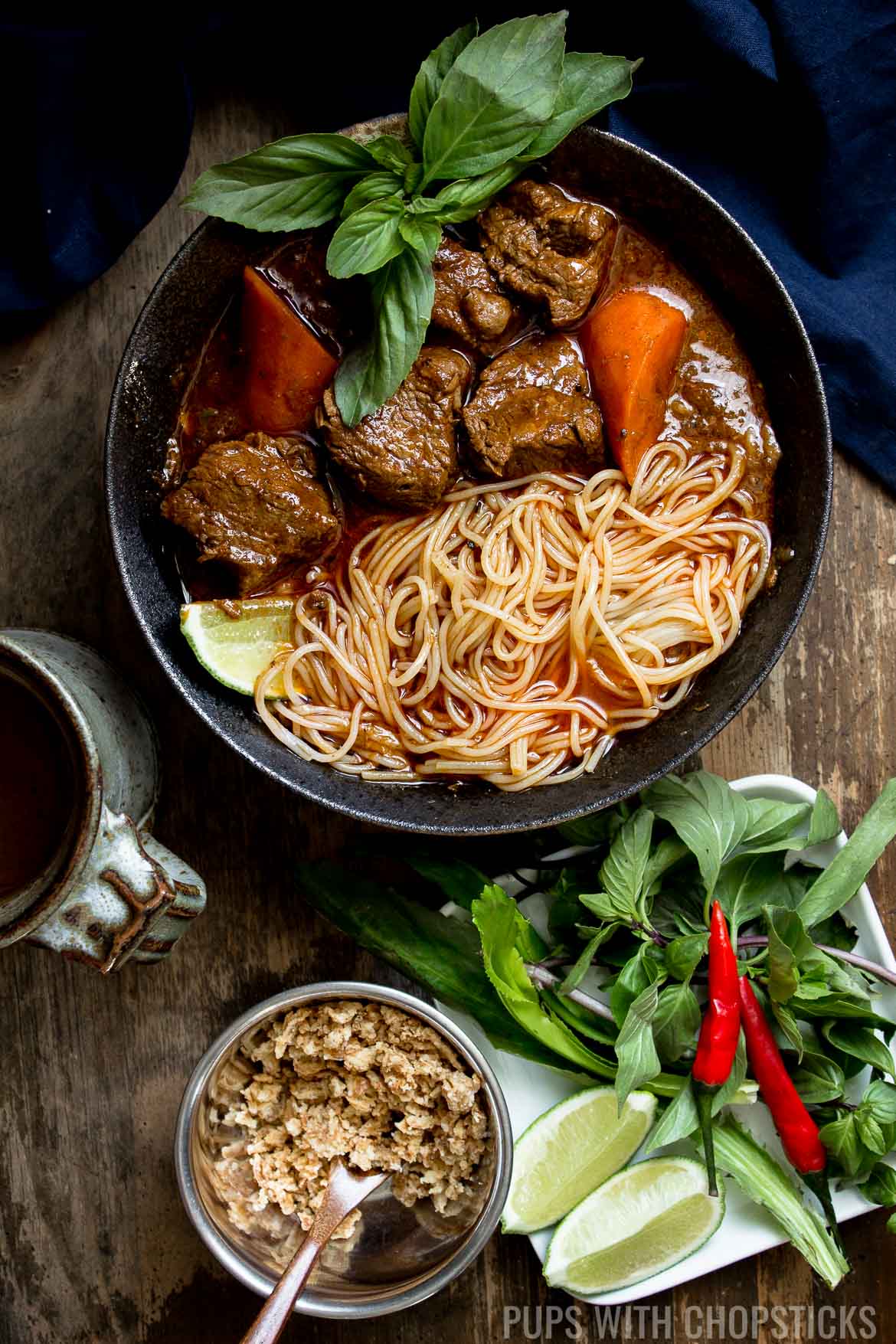
More Vietnamese Recipes You May Like
- Bun Bo Hue (Spicy Vietnamese Beef Noodle Soup)
- Vietnamese Grilled Shrimp Vermicelli Noodle Bowl
- Vietnamese Grilled Lemongrass Pork Chops
- Nem Nuong (Vietnamese Grilled Pork Sausages)
- Nuoc Cham Vietnamese Dipping Sauce
- Canh Chua (Vietnamese Sweet and Sour Soup)
- Vietnamese Lemongrass Chicken
If you like my recipes and want to be updated on when new ones come out, please consider subscribing to my newsletter (we don't spam) and follow along on Instagram, Facebook, and Pinterest for all of my latest recipes!
Recipe Card
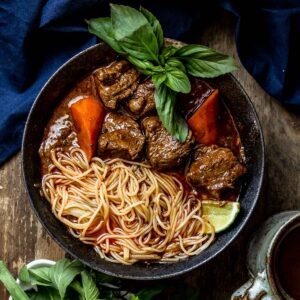
Bo Kho (Vietnamese Beef Stew)
Joyce's Recipe Notes
- If you use beef shank or oxtail, you will need to increase the cooking time, since they are tougher cuts of beef. Definitely worth it though.
- If you use oxtail, you will get less meat if you use 1.5kg of oxtail since the majority of the weight will come from the bones.
- If you like your beef stew spicy, you can add 1-2 Thai chilies into the stew while the beef is braising.
- It's important not to marinate it for more than 24 hours because kiwi is a very strong meat tenderizer, and it may tenderize the meat too much and make it mushy.
Ingredients
Beef Marinade
- 1 kg beef (shank, oxtail, boneless rib, chunk or sirloin tip - see notes)
- 1 kiwi (smashed)
- 1 can of cola (355 ml, approximately 1 ½ cups)
- 2 inch ginger (cut roughly into strips)
- 2-3 garlic cloves (roughly chopped)
- 1 onion (cut into slices)
- 2 teaspoons five spice powder
- 1 teaspoon fish sauce
Bo Kho Stew Ingredients
- 2 inch fresh ginger (sliced thickly)
- 4 cloves garlic (roughly chopped)
- 1-2 onions (sliced)
- 2 stalks lemongrass
- 1 cinnamon stick (2 inch long)
- 3-4 star anise
- 3 bay leaves
- ¼ cup tomato paste (add an additional 2 tablespoons if you want a thicker stew)
- 2-3 tablespoons butter
- 3 tablespoons fish sauce (adjust to taste)
- ¼ cup shaoxing cooking wine (or dry sherry)
- 2 large carrots
- 4 cups low sodium beef broth (32oz)
(Optional) If You are Transforming it to a Noodle Soup
- 1-3 cup beef broth (add more if you like a thinner soup for noodles)
- fish sauce (adjust to taste)
Garnishes
- ½ white onion (or any sweet onion, thinly sliced - don't skip this, it really adds a lot of flavor to the final dish)
- fresh basil
- lime wedges
- crispy deep fried shallots
Instructions
Marinate the Beef
- Cut the beef into 1 ½ inch chunks and place it in large bowl
- Roughly chop 2-3 garlic cloves and 1 onion and place it in the bowl
- Cut a 2 inch piece of ginger and, cut them into thick matchsticks, and place them in the bowl
- Add the 2 teaspoons five spice powder, 1 teaspoon fish sauce and 1 can of cola in the bowl
- Peel 1 kiwi and smash it with the fork, put the smashed kiwi in the bowl
- Mix everything well and marinate it overnight in the fridge. If you're pressed for time, marinate it for at least 4 hours in room temperature.It's important not to marinate it for more than 24 hours because kiwi is a very strong meat tenderizer, and it may tenderize the meat too much and make it mushy.
Preparation
- Once you are done marinating, remove the marinating beef from the fridge, drain and discard the liquid.
- Discard the arromatics (the onions, garlic and ginger). Don't worry we use fresh arromatics for the stew.
- Let the beef sit in room temperature for an hour, this will help with the browning of the beef since the beef won't be as cold.
- While we are waiting for the beef, peel and slice 1-2 onions and set it a side
- Peel and roughly chop 4 cloves garlic and set it a side
- Cut out 2 inch ginger, and slice it and set it a side.
- Peel and chop 2 large carrots into 2 inch chunks and set it aside
- Peel the dried outer layer of 2 stalks lemongrass and cut off the dried tips at the top and discard it. Wash the lemongrass to remove any sand. Cut the lemongrass into 2-3 inch chunks and smash it with a rolling pin or the blunt back of your knife to release the oils.
Putting It Together
- Place a large heavy bottom pot or a dutch oven over the stove on medium heat and add a bit of oil with 2-3 tablespoons butter
- When the pot is hot, add the beef in one at a time, careful not too crowd it too much. Brown the beef in batches. (The beef browns better if you touch it less, it gives it a chance to form a crust)
- Once all the beef has browned, add all the beef back in and add in the chopped onions, garlic, ginger, lemongrass, 1 cinnamon stick and 3-4 star anise and toast it with the meat for about 5 minutes
- Add in ¼ cup tomato paste and mix everything well, cook for another 2-3 minutes
- Add in ¼ cup shaoxing cooking wine, 4 cups low sodium beef broth and 3 bay leaves and gently scrape the bottom of the pan if there are brown bits stuck to the bottom (this is flavor).
- Bring it to a boil. Once it has started boiling, reduce the heat to low and put a lid on it and let it simmer. Set a timer for 2 ½ hours. (If you are using oxtail or beef shank, you will need to cook it a lot longer, by approximately 1 hour more)
- Once 2 ½ hours have passed, stir the stew and check the beef for tenderness. If it is still tough continue to cook it for another 30 minutes. If the stew needs more liquid, add more beef broth or water.
- Once it is tender, add in the carrots and continue to cook it for another 30 minutes with the lid on until the carrots are soft
- Add 3 tablespoons fish sauce and adjust it to your taste
- Pick out the lemongrass, star anise, and bay leaves and discard them.
- Ladle some stew into a bowl and serve with a Vietnamese baguette or with rice.
(Optional) Making It Into A Beef Noodle Soup
- Once the stew is done, add in 1-3 cup beef broth (depending on how thin you want the soup)
- Add fish sauce to taste
- Serve with noodles and thinly sliced sweet onions. Garnish with lime wedges and thai basil.
Nutrition
*Nutritional information is calculated using online tools and is an estimate*
Disclaimer: We are a participant in the Amazon Services LLC Associates Program, an affiliate advertising program designed to provide a means for us to earn fees by linking to Amazon.com and affiliated sites. While I appreciate the support – please try to buy your items locally if possible to support your local shops (chances are they are cheaper locally as well!)
More Cozy Recipes You May Enjoy
- Chicken Khao Soi Recipe (Thai Coconut Curry Noodle Soup)
- Authentic Thai Tom Yum Soup (Classic Tom Yum Goong)
- How to Make Chicken Congee (鸡粥)
- Thai Red Curry
- Delicious Homemade Udon Soup (Quick & Easy Noodle Soup)
- Wonton Noodle Soup
- Chinese Braised Beef Stew
- Easy Soondubu Jjigae Recipe (Spicy Korean Soft Tofu Stew)

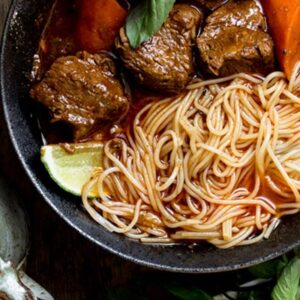
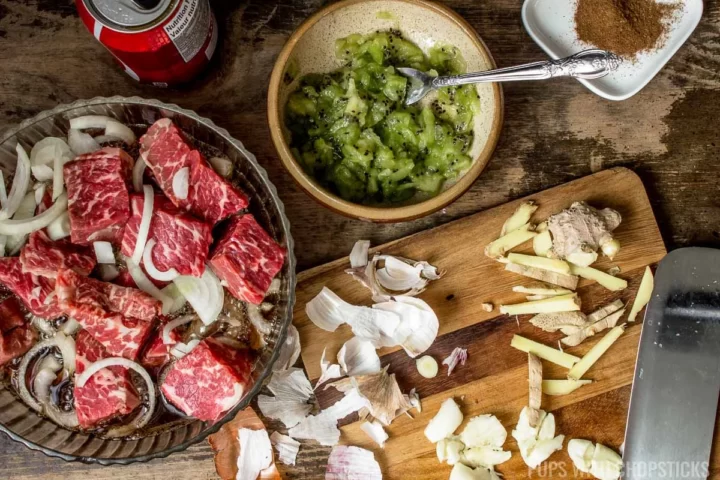


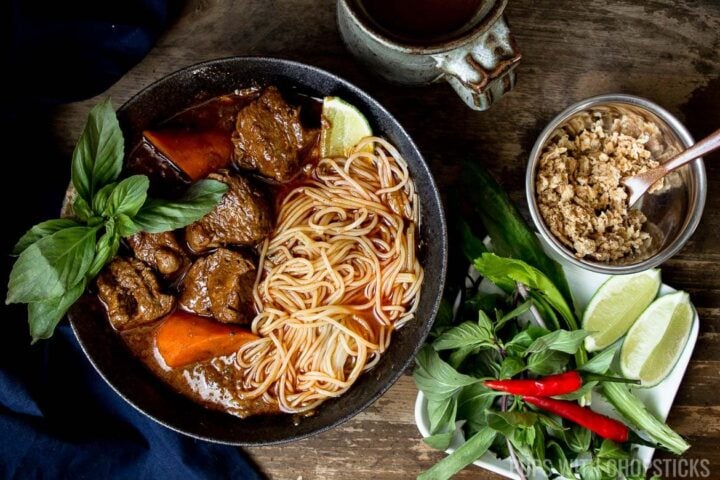
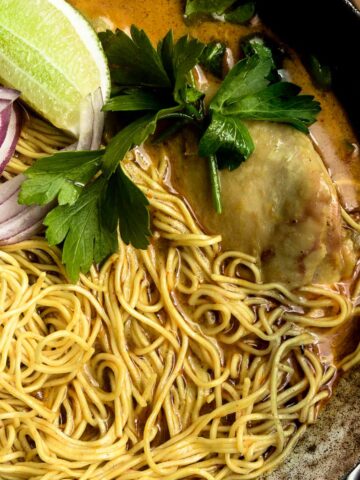
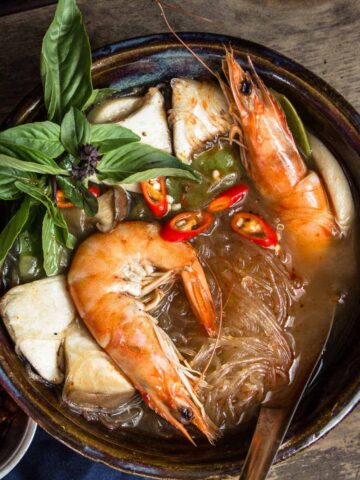
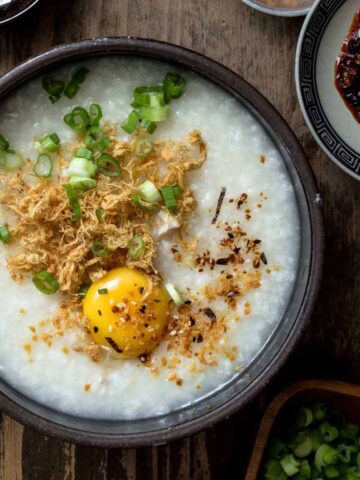
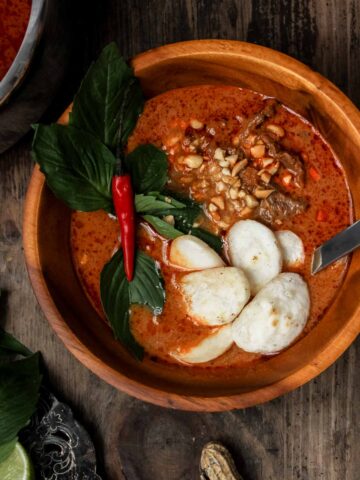
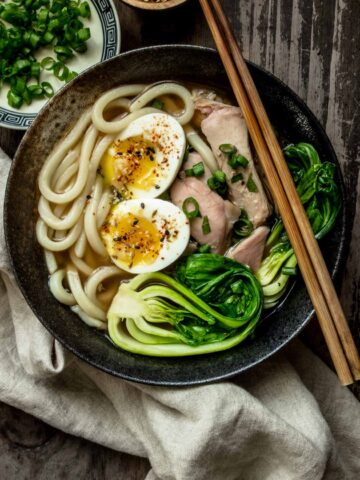
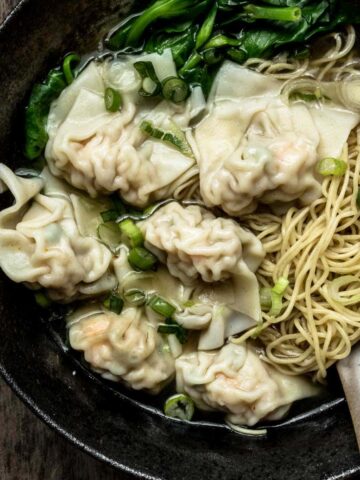
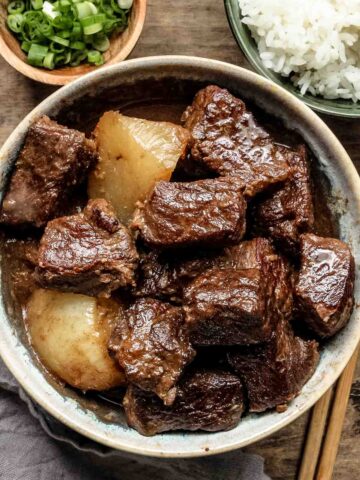
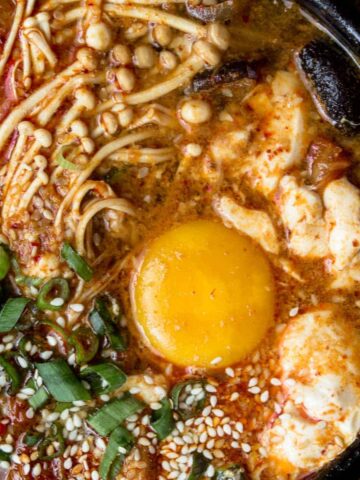

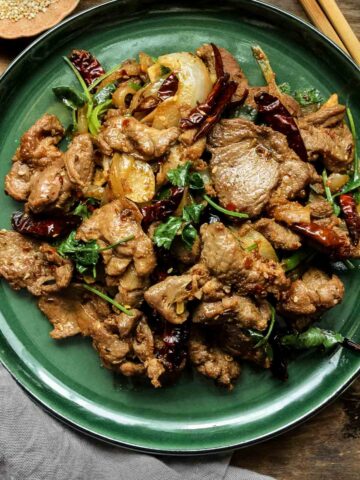
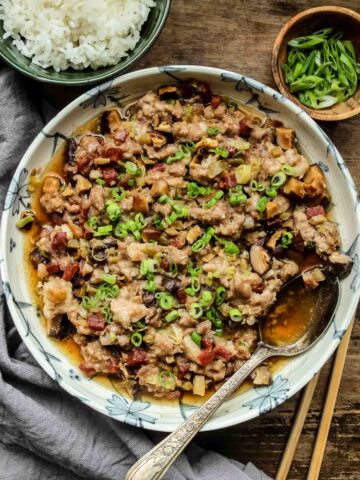
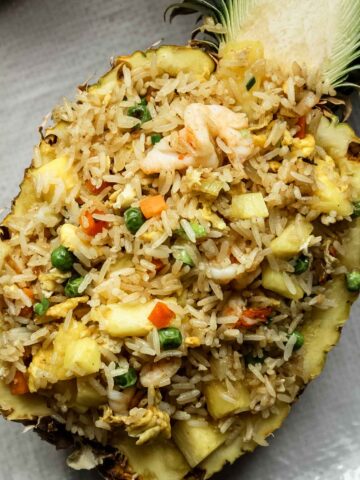
Tin d L says
Hi, do you recommend using the Bo Kho seasoning packets?
Thanks!
Joyce Lee says
Hi Tin!
I have not tried using Bo Kho seasoning packets before, so I'm not sure. I just looked up a few and it looks like it's mostly just spices so I think it should be okay. Make sure to do a taste test of the spices to see how salty it is before adding it in, and then adjust the stew at the end with fish sauce, and sugar to balance out the saltiness.
Hope this helps!
Candace Reading says
Hey, would this work for venison?
Joyce Lee says
Hi Candace!
I have not tried cooking it with venison so I'm not really sure...I'm sorry I couldn't be more help!
Josie says
I followed your recipe to cook, very yummy food. 👍
Joyce Lee says
Hi Josie!
I'm so happy you liked it!
Mei says
After marinating the beef over night and After Browning the meat the next morning, do you think it would cook enough in a slow cooker all day? Im using chuck steak.
Thanks!
Joyce Lee says
Hi Mei!
I haven't tried using a slow cooker but I think you can do it. You need to cook it hot enough that the connective tissues start to break down. (around 200f) that's how it will get tender and soft.
If I had to guess, I would say you can cook it on low for 8-10 hours or on high for about 5 hours but make sure you don't run out of liquid.
Hope this helps!
Joyce